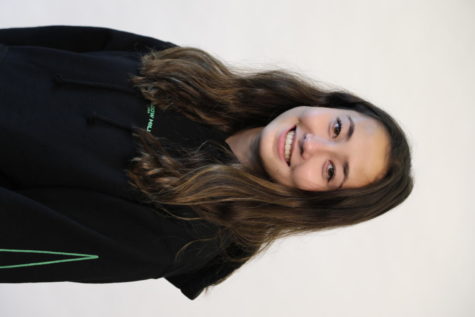How I Dealt with COVID-19 in My Home
After testing positive for COVID-19, my sister was stuck quarantining for ten days. She was asymptomatic, but our family still needed to follow safety protocols. Staff illustration: Dorinda Xiao.
November 30, 2021
The morning of Sept. 15, 2021, began normally for my sister, Menlo eighth-grader Amanda Wu. Wu was at her classmate’s house, and she had planned to spend her day off from school with friends. But by noon, Health Services Coordinator Joan Barada called our mother, informing her that Wu had tested positive for COVID-19. For the following 10 days, she was ordered to follow strict quarantine, in accordance with the Centers for Disease Control and Prevention’s guidelines.
Because I’m her sister, I expected that I would contract COVID-19 immediately so I was surprised when I didn’t. When she first tested positive, I wasn’t at home. I was out with friends, so when my parents called to inform me of the news, we all panicked together. I drove straight to a COVID-19 testing center at Stanford.
By the time I arrived home a few hours later, my home had already been transformed to accommodate my sister’s quarantine. Her furniture had been moved into the guest room downstairs so that she could quarantine in a larger room. In addition to more space, the guest room was in the corner of our home, making it easier to isolate her from the rest of the family. The door between the room and the rest of the house remained closed for the length of the quarantine. To assist Wu, my parents and I instead left food and supplies for her in the backyard. The guest room had a door connecting to the backyard, so Wu could easily pick up whatever she needed, at any given time. This method eliminated my family’s direct contact with her, and it ensured the door between the house and guest room stayed closed.
To further prevent the virus from contaminating the house, my father switched our ventilation systems to a special setting. This adjustment ensured that air was both filtered and not circulated around the whole house, so any air in the guest room wouldn’t be near my parents and me. We also continued to wear masks for the majority of the quarantine as an extra precaution. I wore a mask whenever I was not in my own room, even if I was doing something quick, like grabbing a glass of water. I knew small actions wouldn’t put me at a major risk of contracting COVID-19, but they still proved how strongly my family cared about safety, similar to the rest of the Menlo community.
Despite all the safety measures my family and I took, I lived in constant fear of contracting COVID-19. Wu was asymptomatic, but I still worried for myself and the people around me. By the second day of Wu’s quarantine, my Stanford lab results returned negative, but they still weren’t enough to eliminate my doubts. My parents encouraged me to take rapid tests every morning before school. Rapid tests only required fifteen minutes, so it was an easy solution to my stress. Each morning, my rapid tests were, thankfully, negative.
According to my sister, quarantining in the guest room for 10 days was nowhere near the experience she’d originally expected. Even though Wu was still living in her own house, she had not spent much time in the guest room previous to her quarantine. “It was weird because I was still at home, but I couldn’t go to any of the spots I’m usually in,” Wu said. “There were so many limitations.”
I shared a similarly weird experience to Wu, even though I wasn’t in a quarantine myself. Wu and I always spend time together in our rooms before and after school, and not being able to do that while still knowing she was elsewhere in the house was very strange. I could even hear her watching TV or on the phone through our house’s walls, but I wasn’t able to speak to her face-to-face. Plus, the house alarms would chime constantly, signaling that a door in the house had been opened by Wu to the backyard. COVID-19 clearly impacts physical health, but these sounds reminded me that it also impacted my sister’s mental health — she had no choice but to experience quarantine all alone.
My only form of communication with Wu throughout her quarantine was social media. It was easy to text or FaceTime her occasionally to see that she was doing okay in the guest room. In this room, Wu attended school virtually, via Zoom. Even though Menlo was hybrid for the 2020-21 school year, this year school is completely in-person. Students with COVID-19, such as my sister, must be approved to participate online. According to Wu, since she was one of the only online students, she felt quite behind in class. “Zoom worked last year, but it didn’t really work when I was the only student online,” Wu said.
During the 10-day quarantine, Wu tested twice at Stanford and took multiple rapid tests. All of them were negative, despite the positive test from Menlo’s Inspire Diagnostics testing. However, according to CDC guidelines, Wu still needed to quarantine in case her positive test was the accurate one. “It was really frustrating the whole time because I had so many other negative tests,” Wu said. “But, it was better to be safe than sorry.” According to Wu, it’s frustrating that she’ll never be able to confirm if she received a positive or false positive lab result.
Even though many of her friends believed her test was a false positive, Wu felt slightly stigmatized by her lab results. Wu agreed that her quarantine was necessary, but even after it was completely over, some of her friends were hesitant to see her.
I didn’t have COVID-19, but I can agree that I felt treated differently once my family was associated with the virus. When I was first told my friends about my sister’s quarantine, we collectively acted cautiously about making any plans to hang out, especially before I’d received my own Stanford results. Still, after I tested negative from Stanford, my friends and I talked with our parents to ensure spending time together wouldn’t put anyone at risk. My friends were kind to me about the whole situation, but at school, I was nervous that students who found out would be scared to be around me, even though I wasn’t sick.
I was especially anxious because when kids in my grade had previously been sent home with COVID-19, students would gossip and try to figure out how much they’d been in contact with the sick student. “I definitely felt talked about at school,” Wu said. Even though Menlo prioritizes confidentiality when students have COVID-19, my sister pointed out that it is pretty easy to figure out when someone is sick if they switch from in-person school to Zoom.
Experiencing COVID-19 in my household was scary, but it also made me feel a little more prepared for the future. While my family’s lucky that Wu demonstrated zero symptoms, we now know exactly how to act if the situation ever repeats itself. With this experience, I am now much more aware of the main emotion I associate with the pandemic: fear.




